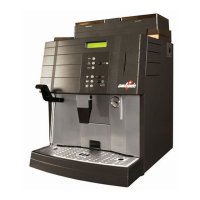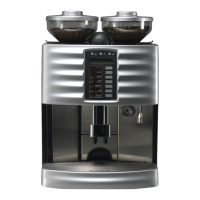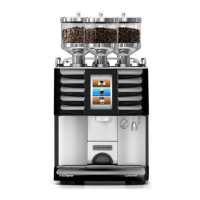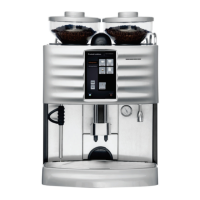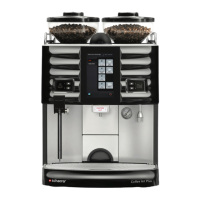Chapter 3 Functional descriptions
56 SMSO-2-02.03- 15.07.03
3.2.17 Booster
The booster is a heat storage device that transfers its heat to
the brewing water for the first servings of the product before it
enters the brewing cylinder. This compensates for the loss in
temperature in the brewing water through the brewing valve.
With this system, the brewing or outlet temperature can be
maintained at the optimum set values. In particular, this en-
ables those products that use small amounts of water (ris-
tretto/espresso) always to be served at a constant quality, from
the first cup onwards.
The booster consists of an aluminum body with a bore hole for
the water flow and a built-in heating cartridge. The temperature
is controlled by turning the heating cartridge on and off. The
temperature sensor connected to the housing transmits the
control signals. A safety fuse is built into the heater power
circuit as a safety element against over-temperatures.
The entire booster body is surrounded by heat insulation. It is
completely wired as a unit into the machine and used as a
replacement part.
Drawing symbol
Illustration
Booster
1 Base body
2 Hole for water to flow through
3 Heating element
4 Temperature sensor
5 Plug casing
6 Over-temperature safety fuse
7 Insulation tube
8 Cable holder
9 PEEK connection nipple
Technical data
Nominal voltage: 36 V DC
Power rating: approx. 20 W
Resistance of
heating element at 20
o
C: approx. 35 -38 Ohm
Resistance of
Temperature sensor: 20 °C = 12.5 kOhm
26 °C = 9.6 kOhm
30 °C = 8.0 kOhm
Operating temperature: 110
o
C (hard coded)
Over-temperature safety fuse: 135 °C
Maintenance
Most frequent faults
clogged due to contamination / coffee residues
The unit does not evacuate correctly (pipe clogged /
closed)
The end of the discharge pipe is immersed into the water
level of the siphon.
Check
Check for contamination and coffee residues
Optimum heat transfer from the metal body (i.e. the heat stor-
age unit) to the brewing water can take place only if the hole is
clean and not clogged with residues or deposits. Slow heat
transfer has a negative effect on the quality of the product.
Service intervals
After every 45,000 coffee servings or after 12 months of op-
eration check the following:
Contamination
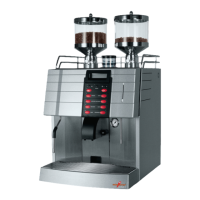
